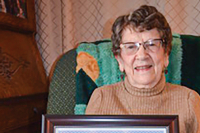Painting the town orange
 A slap-happy spray paint job by a utility contractor has tarnished the quaint brick sidewalks in downtown Waynesville with obtrusive and excessively large orange stripes.
A slap-happy spray paint job by a utility contractor has tarnished the quaint brick sidewalks in downtown Waynesville with obtrusive and excessively large orange stripes.
“That guy just went nuts,” said Fred Baker, Waynesville’s public works director. Baker, needless to say, is not a fan of the overzealous spray paint job.
The orange paint markings are unattractive and out-of-place, even jarring for the scene that Waynesville’s historic downtown evokes. The not-to-be-missed marks on the sidewalk and street have been the source of plenty of rumors. So first, a few disclaimers:
• The paint isn’t permanent. It will fade out eventually, but it could take a few months.
• The town of Waynesville had nothing to do with the spray painting.
Related Items
• The marks aren’t a harbinger of major street and sidewalk construction during the peak of Main Street’s hoppin’ tourist season, heaven forbid.
• And, no, they aren’t denoting a special lane for Segways.
The marks are the work of a utility locator with an itchy trigger finger.
“We have a term for that — it is called industrial graffiti,” said Doc Asbury, a spokesman for the state’s “Call Before you Dig” hotline.
So what are the orange marks for exactly? Indeed, that was the hot topic downtown last week.
“I thought they were putting in bike lanes,” said Nora Smith, a waitress at Café 50, based on the diamond symbols in between the stripes.
But here’s what really happened. Someone had phoned the “Call Before You Dig” hotline and set off a flurry of street and sidewalk spray painting to map underground utilities. It’s known as “a trace” or “a locate.”
Anyone planning to dig or excavate can call in for something as simple as a restaurant wanting to run a natural gas line or homeowner fixing a sewer blockage. The “Call Before You Dig” clearinghouse issues the alert to any utilities known to have lines in that area.
The utilities in turn dispatch their legions armed with cans of spray paint and tiny flags to mark where their lines are.
Baker could quickly figure out who the offender was. As public works director, he carries a card in his shirt pocket for quick reference denoting what each color of paint stands for in public works’ circles.
Gas is yellow, water is blue, sewer is green, electrical is red, and so on.
“There is so much underground utility wise. Whether it is telephone or gas or water, sewer, electric — everybody has a color code,” Baker said.
The town got the same utility locator alert. And it dutifully sent out its people to mark its water lines, sewer lines and electrical lines. But Baker said the town is far more judicious in how much spray paint to apply. A short dash every 15 feet is ample.
“There was no point in a continuous marking all the way up and down the road,” Baker said.
Nor in such a wide track.
“Why mark a swath six feet wide?” Baker said.
The answer to that question hasn’t been easy to ferret out. Orange paint stands for telecommunications, which in this case was AT&T. But before throwing stones at AT&T, there’s more to the story.
First, major utilities use outside contractors to do the sidewalk dirty work. It is such a big business, a national corporation has a sophisticated network of contractors that are dispatched on behalf of utilities whenever dig alerts come through. The Smoky Mountain News was unable to get through to the actual field contractor who bore the orange paint can that day. We do know he works for the national utility locating firm USIC.
Jeannie Tracy, the owner of Jeweler’s Work Bench on Main Street, talked to him while he was marking the sidewalk. He was nothing if not diligent, Tracy said.
After each mark he made, he stopped and photographed his work.
“I am not sure how overzealous he was of if he was just following his instructions,” Tracy said.
The hyper vigilance is actually a good thing, according to Josh Gelinas, a spokesperson for AT&T corporate in North and South Carolina.
The AT&T conduit below ground carries not only phone lines but fiber optic. Severing them could knock out communications for all of downtown, or even wider if it is a main trunk line.
Then we’d have a much bigger story on our hands than orange sidewalk paint, Gelinas said.
Source of the matter
Digressions aside, what, pray tell, is the actual project that prompted the orange paint hack job? It’s such an obscure project, tracking it down wasn’t altogether easy.
Many, many years ago, there was a old dry cleaners at the corner of Church and Montgomery streets. It could have leached pollutants. State environmental officials want to determine if there are lingering contaminants underground — thus the state dug a groundwater monitoring well in the vicinity of Frog’s Leap Public House.
Yet four to five city blocks were marked up when the digging was isolated to a single intersection. Thus some of the blame rests with the person who called in the utility alert.
“I had no idea they were going to call in a locate for that wide of an area,” Baker said. “Why they traced all the way up to Main Street is beyond me.”
The guy who called it in, however, apparently ascribes to the motto “better safe than sorry.”
“The orange marks seem like overkill sometimes, but it is better to have it marked than cause hundreds of thousands in damage,” said John Maas, a geologist from the greater Charlotte area.
Maas also said he wasn’t quite sure where the monitoring well was going to go yet, so he asked for a wide birth.
But Doc Asbury with the “Call Before You Dig” clearinghouse said that’s not really the best practice.
“Only ask for a locate in the area where you are going to be digging,” Asbury said.
Baker said the “Call Before You Dig” clearinghouse system is a good thing in all. People digging don’t have to worry about calling half a dozen different utilities. Just one call, and all the utilities get notified through the clearinghouse.
“We were just tearing up each other’s stuff way too much,” Baker said of the days before the system was put into widespread use.
But the system is so streamlined, it’s actually a downfall. No one has to actually talk to each other anymore about the work they are doing. In this case, an outside contractor phoned in a utility marking alert that was carried out by another outside contractor.
No one from the town nor the utility itself had a chance to parley and ask for a little slack in the size and quantity of markings.
Asbury said the town could pass an ordinance stipulating how sidewalk utility spray painting is done. There is even the option of requiring “offset” marks in the street instead of the sidewalk.
A right way, and a wrong way
Whether the paint marking job was overkill may be in the eye of the beholder. One would assume this picturesque downtown, with its brick sidewalks and lamp posts and National Historic District designation, calls for a little more discretion.
Downtown Waynesville is the crème de la crème in its league. It routinely wins accolades — there’s too many Top 10 lists and awards to even list here. A recent notch on its belt came just this month, when it was voted “Best Downtown” in the Southern Appalachians by readers of Blue Ridge Country magazine.
“It is annoying,” Baker said of the marks. “It is not going to fade out till the end of the summer.”
Or maybe, if downtown merchants are lucky, it will stick around until Halloween.









